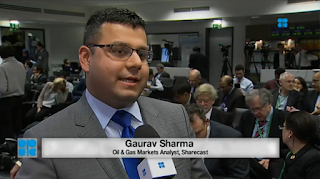In case you have been on another planet and haven’t heard, after weeks of chatter about coordinated oil output cuts by OPEC and non-OPEC producers, we finally had some movement. The Oilholic deploys the word 'movement' here rather cagily.
Three OPEC members led by heavyweight Saudi Arabia, with Qatar and Venezuela in tow, joined hands with the Russians, to announce a production ‘freeze’ at January’s output levels on Tuesday, provided ‘others’ agree to do likewise.
The most important others happen to be Iraq and Iran who haven’t exactly come out in support of the said freeze just yet. Even if they do agree, or in fact all OPEC members agree, the freeze would come at production levels deemed to be historical highs for both the Russians and OPEC. In case of the latter, industry surveys and data from aggregators as diverse as Platts and Bloomberg points to all 12 exporting OPEC nations collectively pumping above 32 million barrels per day.
Predictably, the oil futures market treated the news of the 'freeze' with the sort of disdain it deserved. The price remains stuck in the range where it has been and short-term volatility is likely to last; so much of what transpired was, well, exceedingly boring from a market standpoint, excepting that it was the first instance of OPEC and non-OPEC coordinated action in 15 years.
Predictably, the oil futures market treated the news of the 'freeze' with the sort of disdain it deserved. The price remains stuck in the range where it has been and short-term volatility is likely to last; so much of what transpired was, well, exceedingly boring from a market standpoint, excepting that it was the first instance of OPEC and non-OPEC coordinated action in 15 years.
If OPEC really wants to support prices, an uptick in the region of $7-10 per barrel would require the cartel to introduce a real terms cut of 1.5 million bpd. Even then, the gains would short-term, and the only people benefitting would be North American players. Some of them are the very wildcatters, whose tenacity for surviving when oil is staying ‘lower for longer’, OPEC has so far failed to work out with any strategic coherence. Expect more of the same in a market that's still awash with crude oil.
Finally, just before one takes your leave, it seems Moody's has placed on review for downgrade the Aa3 ratings of China National Petroleum Corporation (CNPC), Sinopec Group, Sinopec Corp, China National Offshore Oil Corporation (CNOOC Group) and CNOOC Limited.
The ratings agency has also placed on review for downgrade the ratings of the Chinese national oil companies' rated subsidiaries, including Kunlun Energy Company Limited, CNPC Finance (HK) Limited, CNPC Captive Insurance Company Limited, CNOOC Finance Corporation Ltd, and Sinopec Century Bright Capital Investment Limited.
In a statement, Moody’s said global rating actions on many energy companies, reflect its efforts to "recalibrate the ratings in the energy portfolio to align with the fundamental shift in the credit conditions of the global energy sector." Can’t argue with that! That’s all for the moment folks! Keep reading, keep it ‘crude’!
To follow The Oilholic on Twitter click here.
To follow The Oilholic on Google+ click here.
To follow The Oilholic on Forbes click here.
To email: gaurav.sharma@oilholicssynonymous.com
To follow The Oilholic on Google+ click here.
To follow The Oilholic on Forbes click here.
To email: gaurav.sharma@oilholicssynonymous.com
© Gaurav Sharma 2016. Photo: Oil exploration site in Russia © LukOil





